Categories
Subjects
Authors
Artists
Venues
Locations
Calendar
Filter
Done
October 20, 2023 – Feature
London Roundup
Chris Fite-Wassilak
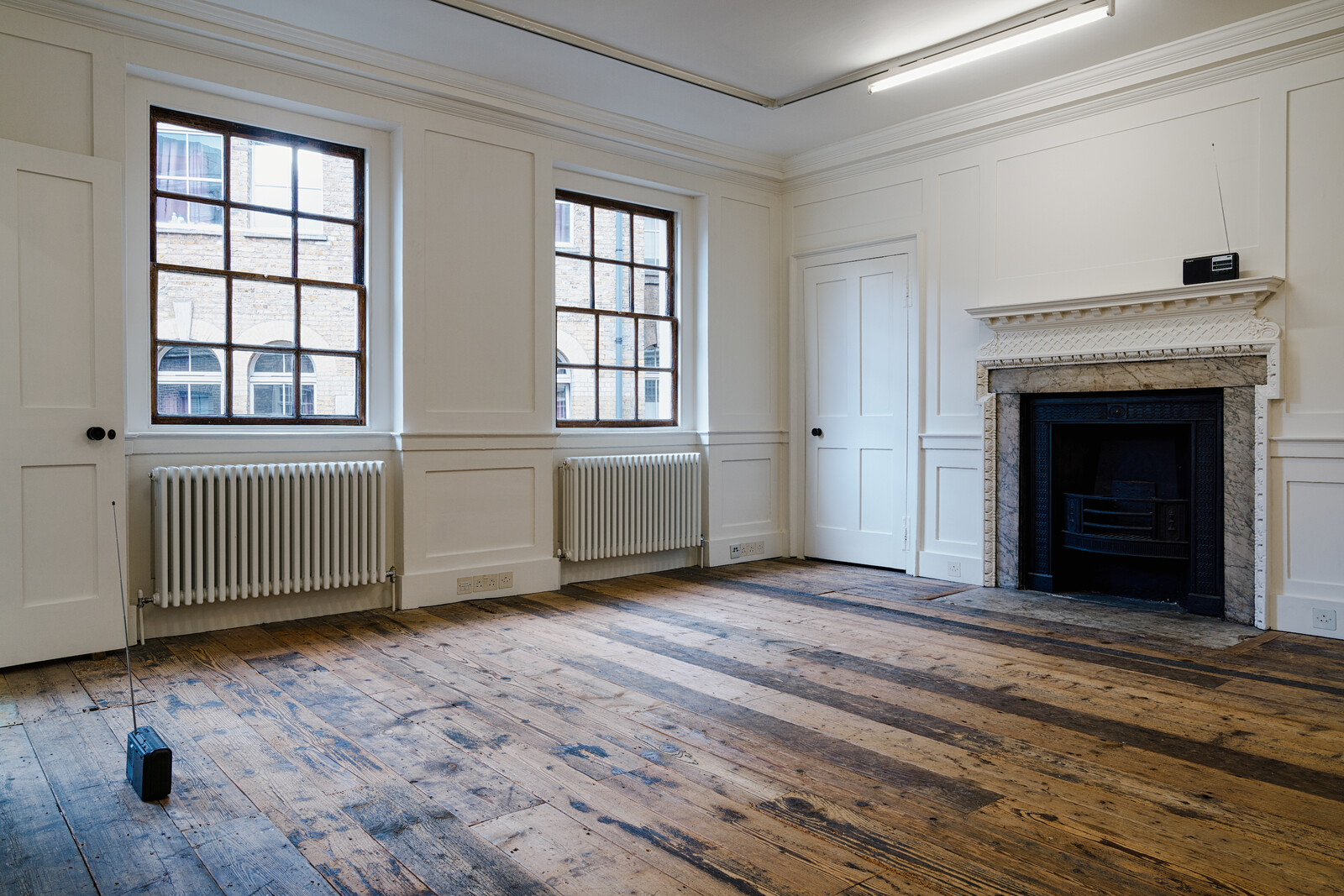
“Celebrating 20 years,” ran the bus and magazine ads for Frieze London, keen to capitalize on having reached a milestone. In 2003, the first fair was welcomed as a galvanizing and creative force—a Studio International review from the time breathlessly described it as the “the real thing […] the apotheosis of swing […] the Stargate.” Such enthusiasm seems cute now, after the artist projects that supposedly set the fair apart from other trade events (Mike Nelson earning a Turner Prize nomination in part for his 2006 installation at the fair) have been scaled back almost to invisibility, and the “Focus” section for younger galleries, introduced in 2013, effectively assimilated parallel smaller fairs such as Zoo and Sunday. Of the 164 stand-holders at this year’s Frieze London, only 30 of them (predominantly, of course, the larger multi-venue galleries) were at the first 2003 fair. Through all this, the fair has long presented itself as an annual temporary institution, masquerading as such among the long-term underfunding of the city’s public museums.
This hoarding of resources has a distorting effect on coinciding and parallel events that would otherwise register as an alternative, both to the fair and other art spaces around London. Several …
October 7, 2019 – Feature
London Roundup
Chris Fite-Wassilak
%20provisioning_hr.jpg,1600)
The world is burning. This is not a metaphor. The sky is bleached a searing lime green, tinged with burned orange that reflects off relentless choppy waves. Suddenly, the sky goes blood red and the horizon blackens, the sun a dull hole punched in the sky. Our view shifts, panning quickly to the left, then back again, as if searching for something, anything. The sky then changes again to a blinding sherbet yellow. The screen depicting this scene, mounted on a metal rack above a whirring circuit board, gives us a certain vision of our current reality. The shifting colors are a translation of information from a small atmospheric monitor mounted on the back of the rack. It’s not clear what directly causes the hues to brighten or waves to get that bit higher or more intense in Yuri Pattison’s sun[set] provisioning (2019) at mother’s tankstation—whether the car exhaust from the street outside, or the hungover breath from bodies in the room might make the scene that bit more trippy. The contraption offers a heavily mediated fiction, but it also makes an actuality visible and present: a drowned world, made hallucinatory and beautiful by toxins that saturate the air and …
October 12, 2018 – Feature
London Roundup
Mariana Cánepa Luna

Just as Frieze Art Fair opened last Wednesday, Prime Minister Theresa May gave her keynote speech—and dared to dance again—at the Conservative Party Conference in Birmingham. She announced that freedom of movement would be terminated “once and for all” by limiting access to “highly skilled workers” (in short, migrants earning over 30,000 British pounds per year). Countless art professionals earn much less (including entry-level curatorial staff at Tate, and yours truly), as well as doubtless many of the myriad gallery and museum folks involved in the city-wide jamboree of Frieze week. How do we imagine London’s contemporary art ecology post-Brexit, a scene that has grown exponentially since Tate Modern’s opening in 2000 and the first Frieze Art Fair in 2003? The question of how the 2019 edition of the fair is going to be affected was the elephant in the tent. Most people I asked shrugged: negotiations are still ongoing, consequences are yet to be seen. “It’ll be fiiiiine,” a London museum director told me. “Maybe we’ll visit a smaller fair, like the first editions—remember those days?” opined a British gallerist friend working in New York. Although one could put this upbeat denial down to the cliché of dark British …
October 6, 2017 – Review
Frieze Art Fair
Herb Shellenberger
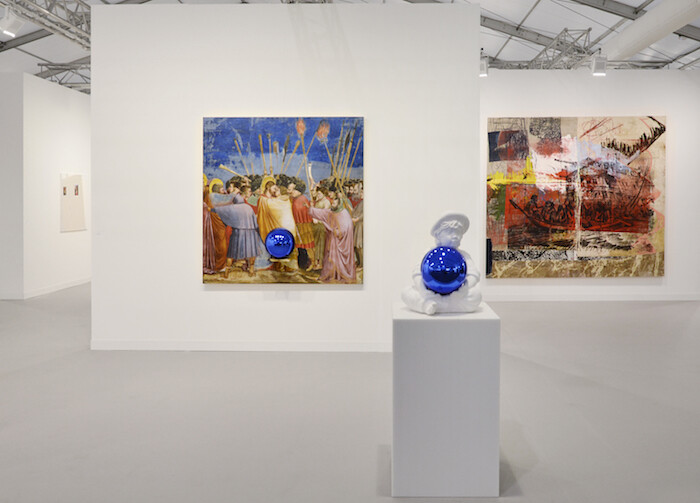
Leave or Remain, Trump or Clinton, terror, peace, boredom, or indifference: no matter where the world is at culturally, politically, socially, or existentially, there will always be another Frieze fair in early October. If last year’s edition occurred within the shadow of a particularly pronounced period of political uncertainty, by now the cards have all been shuffled and we know where we’re at (or more likely, where we’re heading). But “art”—often thought of as a mirror of society at large—can feel particularly distorted in the art-fair setting: both figuratively, in terms of the forms and themes highlighted; and quite literally, as in any number of the inordinately large selection of selfie-ready mirror works that hang in wait. And selfie I did, in an untitled 2015 work by Isa Genzken at New York’s David Zwirner that provided a low-tech, analog method of pixelization.
Perhaps it’s not wise to expect this enormous commercial endeavor to do justice to the things that make art something that we want to look at, make, or participate in, something we think about incessantly. Maybe the art fair has as much to do with art as a wedding convention has to do with love. But as art is …
November 9, 2016 – Review
“Frieze Film”; “Experimenta”; Philippe Parreno’s “Anywhen”
Herb Shellenberger
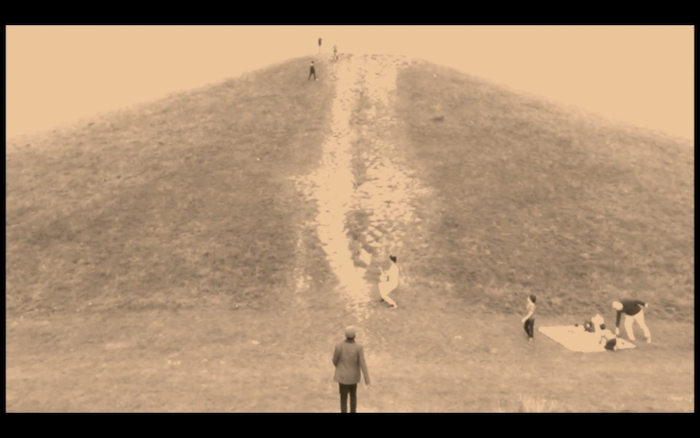
“A repetitive moment becomes eternity.” This fragment of speech, ringing through Tate Modern’s Turbine Hall in Philippe Parreno’s installation Anywhen (2016), might equally describe the frustration or elation of viewers’ experiences of moving image artworks. This season’s blockbuster exhibitions of film and video—Frieze Film (October 6–9, 2016), BFI London Film Festival’s Experimenta (October 6–16), and Parreno’s commission for Tate Modern (October 4–April 7, 2017)—showcased new works in these media through a variety of structures, some more effective than others.
When considered against the relative paucity of moving image works in the booths of Frieze Art Fair this year, the Frieze Film project—which commissioned work by Samson Kambalu, Rachel Maclean, Shana Moulton, and Ming Wong—seemed like an effort to redress the balance. The works were shown at scheduled times in the Frieze auditorium and also on national television as part of Channel 4’s Random Acts strand, which inserts three-minute shorts between programs. But to those already familiar with the oeuvres of the featured artists, this year’s commissions felt too brief; introductions to their style and ideas, rather than fully formed works.
When it is installed in an exhibition space, as at the 2015 Venice Biennale and now at London’s Whitechapel Gallery (23 August, …
October 6, 2016 – Review
Frieze Art Fair
Filipa Ramos
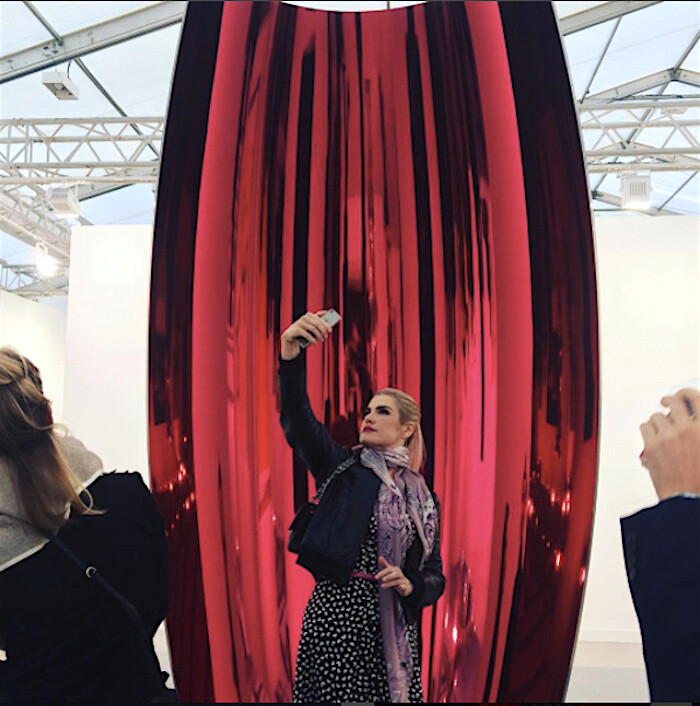
Art fair reviews serve for many as a guide on what to see (and what to avoid); for some as a memorandum on trends, institutions, and artists to follow; and for a few as the starting point for a wish list, supporting acquisition and investment decisions. These texts frequently respond to the intrinsic bipolarity of the fair—an instance that is at once affected by political, economical, and social events while also existing in its own, detached microcosm. It’s not surprising that critics’ attempts to acknowledge contexts and structures often end up entangled in their response to the presentation of artworks as commodities within an enclosed environment, and decline towards impressionistic accounts that mirror the combination of awe, frustration, and exhaustion which is so familiar to fair visitors and workers alike.
Constituted as a playlist, this text is articulated around four music tracks whose spirit and lyrics evoke certain tropes of art fair writing—the identification of highlights and trends, anthropological impressions, considerations on the broader political conjuncture—while proposing an aural experience with which to traverse or imagine the environment of this year’s edition of Frieze London.
Highlights—Brian Eno, “Golden Hours”
The passage of time / is flicking dimly upon the screen, / I …
October 19, 2015 – Feature
London Roundup
Orit Gat
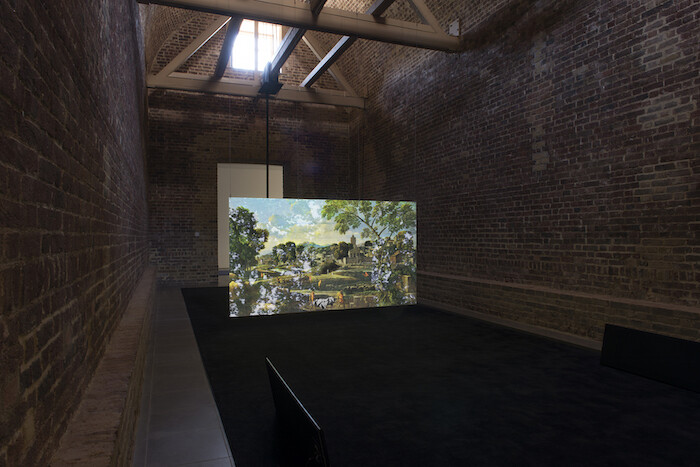
In an art fair week, when it seems like everyone around is constantly discussing where they were, what they saw, and how it was, discourse is dependent on physical participation, on the encounter with art in a space, strengthening the primacy of the exhibition as a mode of experiencing artwork. While there is still a lot of thinking to be made about how display has historically shaped production and continues to do so, Frieze week in London is a great moment to assess whether there is something about the exhibition that makes it such a lasting form.
So why do we still go see exhibitions? Chisenhale Gallery is showing Jumana Manna’s A magical substance flows into me (2015), a 70-minute film screened five times a day. It is an exploration of traditional local music in Palestine/Israel, based on Manna’s research into the work of the German-Jewish ethnomusicologist Robert Lachmann (1892-1939) in Mandatory Palestine. Manna plays radio recordings made by Lachmann on an iPhone to the participants in her film, ranging from a young Jewish musician singing the Arabic songs her Moroccan grandmother taught her to a Palestinian flute maker who explains that traditional Palestinian music is more fashionable in the West …
October 14, 2015 – Review
Frieze Art Fair
Patrick Langley
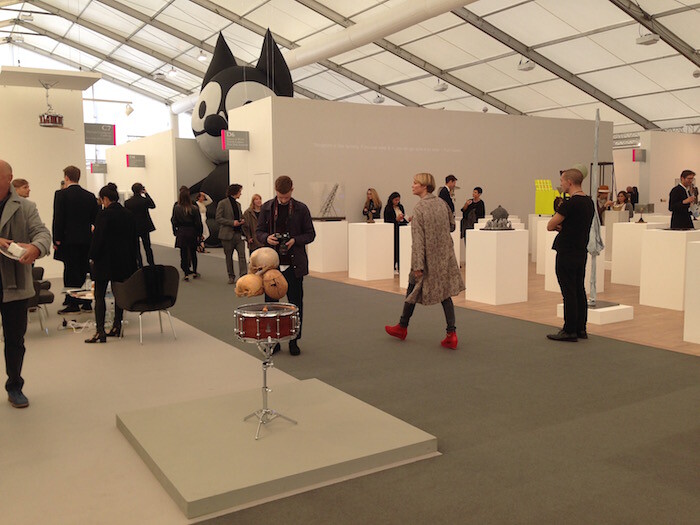
Sociologists have a name for the acute disorientation that half an hour at Frieze London can induce: the “Gruen effect.” Named after Victor Gruen, the Austrian émigré who designed America’s first malls in the 1950s, it describes the sense of temporal and geographical dislocation that sets in when you enter a shopping center. Thrust into a windowless, self-contained space, surrounded by complex arrangements of enticing objects under artificial lights, you begin to lose track of where you are. This is true of Frieze, the layout of which is so complex, and so repetitive, that it is impossible not to get lost however many times you consult the map.
With its bewildering multitude of booths housed under a vast peaked tent, the fair’s main space is a warren of boutiques presenting potential buyers with archly conceptual canvases (Michael Krebber at Maureen Paley, London), playful ceramic sculptures (Jesse Wine at Limoncello Gallery, London; Aaron Angell at Rob Tufnell, also London), LCD screens defaced with graffiti-like smears of oil paint (Ken Okiishi at London’s Pilar Corrias), and a parodic corporate salesroom pitch for a fictional resort (Villagio [2015] by Rancourt/Yatsuk, performed in the auditorium as part of Frieze Live). Frieze offers an astonishing diversity …
October 15, 2014 – Review
Frieze Art Fair
Orit Gat
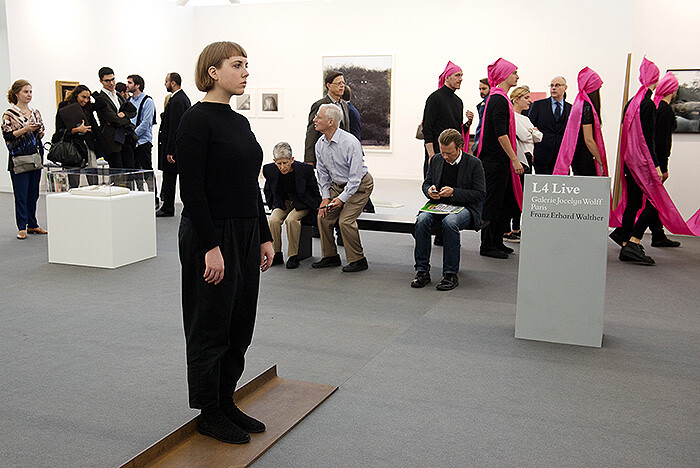
Here’s how you make the most of an art fair booth: hang two-dimensional works on the walls you’ve got, place a large sculpture on the floor in the center, locate a round table with a few chairs in a corner. The result of such standardization is the rise of fair work, which attracts attention by way of scale or repetition. Its most prominent characteristic is its reaction to the architecture of its surroundings through large wall pieces. True to form, the Frieze tent allows artists numerous opportunities to interfere with the temporary structures. Gedi Sibony has hung a ragged brown-gold carpet from the top of Vienna’s Galerie Meyer Kainer’s wall (The Beginning is Near, 2008), allowing it to reach the floor where it is layered over the uniform gray carpeting. Elsewhere, works are attached directly to the light fixtures’ railings, as with Olafur Eliasson’s immense stainless steel ball, Schools of movement sphere (2014) at Tanya Bonakdar, New York, and José Damasceno’s Grua (2010), in which a heavy, rusty hook supports an acrylic disc at Galeria Fortes Vilaça, São Paulo. Others opt for a series of identically framed works meant to make an impression together but sell separately (like the three …
October 17, 2013 – Review
Frieze Art Fair
Lorena Muñoz-Alonso

The ecosystem of Frieze Art Fair in London keeps growing, like a healthy family of good-looking siblings. That is, indeed, exciting, but it is also a real tour de force for visitors, who since last year have not just one, but two highly distinct fairs to enjoy (the main one and Frieze Masters, focusing on the work of more historical figures), as well as an increasing number of side projects and parallel programs, ranging from film screenings, conversations with artists, and musical events.
My journey already commenced on a crisp and sunny Tuesday afternoon, when I scouted out the Sculpture Park, which boasted a rather eclectic selection of outdoor works, encompassing pretty much every artistic style and genre from medieval gargoyles to the shabby chic aesthetic of the artist Oscar Murillo. As I began my stroll, I ran into Judy Chicago, shuffling the blocks of her aptly titled piece Rearrangeable Rainbow Blocks (1965). Not too far way, Jeppe Hein’s Geometrical Mirrors (2011) merged elegantly with the surroundings (disappearing or resurfacing depending on the light and the position of the viewer), and offered the right portions of aesthetic and participatory joy appropriate to such venues, the theme parks of the Instagram-friendly art …
October 11, 2012 – Review
Frieze London Art Fair
Gareth Bell-Jones
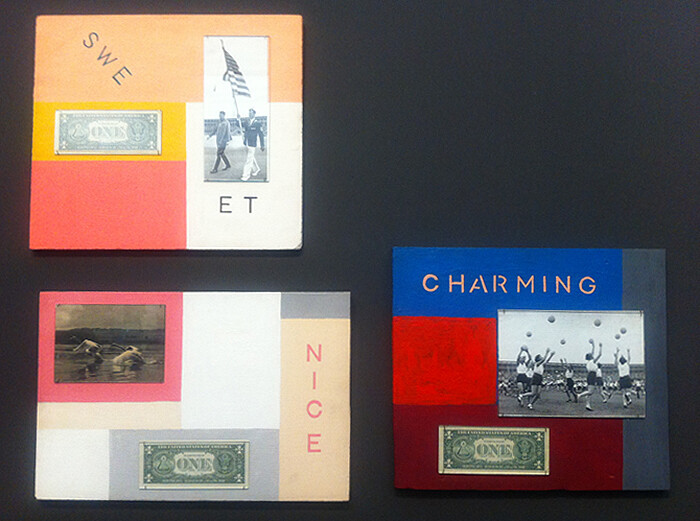
I actually enjoyed going round the Frieze fair this year, which I think is a first. I’ve always felt like a trespasser taking up valuable booth space, dealers looking over the shoulder of my second-hand cardigan. But with this review to write, I had a legitimate reason to take up space. On the day of the preview, I arrived at two o’clock, by which time most of the real business had been done. I just caught the remnants of the bronzed elderly ladies with tight faces and pert breasts shuffling towards main sponsor Deutsche Bank’s champagne lounge (and separate VIP exit). As the day wore on the serious money trickled out as the artists and curators arrived.
Of the tweaks and changes to the format of last year, Frieze Masters is the most prominent and heralded change. The additional art fair in a tent north of the main marquee in Regent’s Park contains artworks made prior to 2000, from African masks and Old Masters to works you used to think were contemporary, placed among the hushed grey and black walls and grey wall-to-wall carpeting. Amid the sea of tweed and pearls, I was pleasantly surprised to find one or two …
October 16, 2011 – Review
Frieze Art Fair
JJ Charlesworth
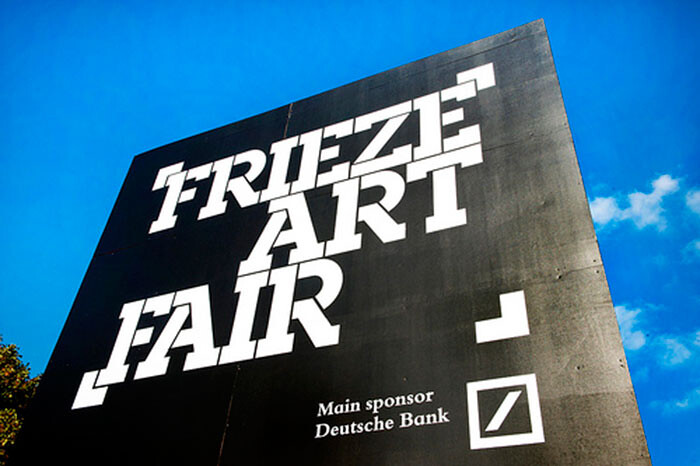
Was the lack of booze a sign? Previously on opening night in the big tent, waves of waiters would set out at a given time to distribute a slow flood of Pommery, gradually inebriating a crowd of revelers.
This year change is afoot. After a hard afternoon of strolling the boulevards of the fair, we started to wonder when the sparkling wave would hit us. So it was a shock to notice that bottles of Pom were being quietly distributed to each gallery stand, to be served at the discretion of the dealers. This year then, getting a drink depended on how much a gallerist decided they liked you. The horror of a critic dependent on a gallerist for a free drink!
But to be fair to the fair, rationing the booze was a good move; after all, as various gallerists I spoke to pointed out, opening night in recent years has tended to get a bit messy. And for sure, the more subdued, polite atmosphere this year seemed to demand more seriousness and consideration from the VIP crowd. But turning down the fizz-quota seems to reflect the broader sense of caution and unease in this year’s edition: with economic uncertainty and …
Load more